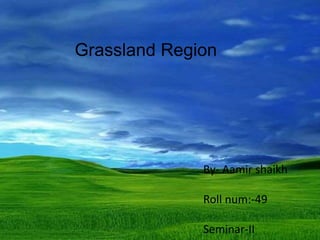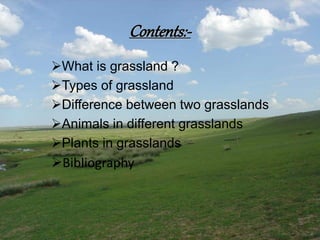Grassland Region
- 1. Grassland Region By- Aamir shaikh Roll num:-49 Seminar-II
- 2. Contents:- What is grassland ? Types of grassland Difference between two grasslands Animals in different grasslands Plants in grasslands Bibliography
- 3. What is grasslands ? • Grasslands are natural ecological communities dominated by grasses and with less than 10% natural tree or shrub cover. They contain many grass species and an even greater diversity of other herbs. • There two kinds of grasslands • Grasslands are areas where the vegetation is dominated by grasses however sedge and rush families can also be found. Grasslands occur naturally on all continents except Antartica. Grasslands are found in most ecoregions of the Earth. For example there are five terrestrial ecoregions classifications (subdivisions) of the ecosystem which is one of eight terrestrial ecozones of the Earth's surface
- 4. Types of grassland There are two types of grassland • Tropical grasslands • Temperate grasslands
- 5. Difference two grassland Tropical grasslands • (i) They are located in the tropical latitude in the interior of the continent in the trade wind belt. • (ii) The grass is tall (3m) coarse and spiky which is neither juicy nor nutritive and there are scattered deciduous trees. • (iii) They are known as the 'big game country' as there is a variety of herbivores and carnivores. • (iv) People practice nomadic herding. • (v) Soil is not very fertile. • (vi) They are known as savannas in Australia and Africa, and llanos and Campos in S. America Temperate grasslands • Temperate Grasslands • (i) They are located in the temperate latitude in the interior of the continent in the belt of Westerlies. • (ii) The grass is short, soft, juicy and nutritive. These are treeless plains as rainfall is less. • (iii) The prairies are known as the 'bread baskets of the world'. • (iv) Commercial farming and commercial herding is carried on. • (v) Soil is very fertile. • (vi) They are known as prairies in N. America, steppes in Asia, pampas in Argentina and Downs in Australia.
- 7. Animals live in Tropical grasslands Giraffes Zebra Buffaloes Kangaroos Lions Hyeans Elephants
- 8. Bibliography Animals of tropical grasslands
- 9. Tropical grasslands animals • Tropical Savannah: Animals The species of animals in a savanna depends upon the geographic location of the biome. The African savannah, the savannah with which most people are familiar, is home to a wide variety of animals. A short list of some of those animals includes wildebeest, warthogs, elephants, zebras, rhinos, gazelles, hyenas, cheetahs, lions, leopards, ostrich, mousebirds, starlings, and weavers. • Animal adaptations During the rainy season, birds, insects, and both large and small mammals thrive in the savannah, but the rainy season only lasts 6 to 8 months. During the dry season, surface water from the rain is quickly absorbed into the ground because the soil is extremely porous. Competition for water during the dry season is intense. Consequently, most birds and many of the large mammals migrate during the dry season in search of water. Because drought conditions are sometimes localized, the migration may be just to another area within the savannah. When drought conditions exist for a long time and over a wide area, the animals may migrate to another biome until the rainy season begins again. Page - 1
- 10. Tropical grasslands animals • Although elephants do migrate, they have a physical adaptation that allows them to access water that is not available to other animals. Baobab trees store water in their large trunks. The elephant's physical strength and anatomy allow it to tear open the trunk of the baobab tree and to suck the water from it. An adaptation used by small burrowing animals is to remain dormant during times of drought--much like bears do during the winter in other biomes. Photos © 2000-www.arttoday.com • During the dry season, lightning frequently ignites the brown, dry grasses that cover the savannah. Many of the animals have adapted to living with the fires. The ability to fly or to run fast enables most birds and large mammals to escape the flames. Some birds, such as the Fork-tailed Drongos, actually are attracted to the active fires. These birds feast on fleeing or flame-roasted insects. Although small burrowing animals may not be able to outrun the flames, they frequently survive the fire by digging beneath the soil and remaining there until the flames pass by them. Page-2
- 12. Animals lives in Temperate grasslands • Zebras • White horses • Lions • Wolves • Jack rabbits • Deer
- 13. Animals of temperate grasslands
- 14. Animals in temperate grasslands • Animals that live in temperate grasslands must adjust to dry terrain in which just 10 to 30 inches of rain falls per year, making temperate grasslands less diverse than the wetter savanna grasslands. Temperate grasslands are characterized by short grasses measuring just a few inches in height. The grasses, upon which many animals in the grassland biome rely for food, thrives during the warm growing season, going dormant during the cold winter.
- 15. Predators • Big cats such as cheetahs and lions hunt prey in temperate grasslands. In North America, wolves, coyotes and foxes hunt for mice, rabbits and deer. These predators help keep populations of grazing animals in check so the grazers do not eat all the grass and other plants in the biome. In the Russian grasslands, polecats, members of the weasel family, make up some of the larger predators.
- 16. Grazers • The grasslands of North America used to provide millions of buffalo with important food resources, but today, few buffalo remain due to hunters killing most of them in the 1800s. Most of the surviving buffalo are protected in state and national parks, including Yellowstone National Park (nps.gov). Antelope and deer use the plains grasslands where they chomp on the short grasses. In Africa, gazelles, zebras and rhinoceros graze on the grass

















